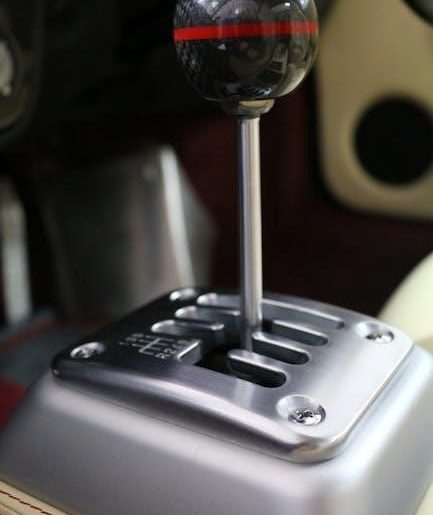The Honeywell Burner Control Manual PDF is a comprehensive guide for installing, operating, and maintaining burner control systems, ensuring safe and efficient combustion processes․
1․1 Overview of Honeywell Burner Control System
The Honeywell Burner Control System is a microprocessor-based solution designed to manage combustion processes efficiently․ It is suitable for various industrial applications, including gas, oil, or combination fuel burners․ The system integrates advanced safety features, programmable logic, and diagnostic capabilities to ensure reliable operation․ It supports single-burner applications and is compatible with multiple fuel types, making it versatile for different industrial needs․ The control system adheres to industry safety standards and provides real-time monitoring and control options․ Its design emphasizes ease of installation, operation, and maintenance, ensuring optimal performance and compliance with regulatory requirements․
1․2 Importance of the Manual for Users
The Honeywell Burner Control Manual PDF is essential for users to understand system operation, installation, and maintenance․ It provides detailed instructions for safe and efficient use, ensuring compliance with safety standards․ The manual includes troubleshooting guides and diagnostic tools, helping users resolve issues quickly․ It also outlines warranty terms and technical support options, offering peace of mind․ By following the manual, users can maximize system performance, reduce downtime, and ensure longevity of the burner control․ The document is a critical resource for both novice and experienced users, covering all aspects of the Honeywell Burner Control System to ensure optimal functionality and safety in industrial environments․ Regular reference to the manual is highly recommended for effective system management․
1․3 Purpose and Scope of the Document
The Honeywell Burner Control Manual PDF is designed to provide users with comprehensive guidance on the installation, operation, and maintenance of Honeywell burner control systems․ Its purpose is to ensure safe and efficient use of the equipment while adhering to industry standards․ The document covers a wide range of topics, including system requirements, wiring diagrams, troubleshooting procedures, and advanced features․ It serves as a single-source reference for technicians, engineers, and operators, offering detailed instructions and technical specifications․ The manual also includes safety protocols, diagnostic tools, and best practices to maximize system performance and longevity․ By following this guide, users can ensure optimal functionality, compliance, and reliability of their Honeywell burner control systems in various industrial applications․

Product Specifications and Features
The Honeywell Burner Control Manual PDF outlines detailed specifications, features, and supported fuel types, including gas, oil, and combination fuels, for various burner control models like RM7890A/B/C․
2․1 Key Features of Honeywell Burner Control
The Honeywell Burner Control systems offer advanced features like microprocessor-based control, flame supervision, and automatic ignition․ They support gas, oil, and combination fuels, ensuring versatility․ Key features include programmable logic, remote monitoring options, and diagnostic capabilities for troubleshooting․ The RM7890A/B/C models provide on/off sequencing, system status indicators, and self-diagnostics, enhancing operational efficiency and safety․ These controls are designed for industrial applications, offering precise burner management and compliance with safety standards․ The integration of microprocessor technology enables advanced functionalities, making Honeywell burner controls a reliable choice for automatic firing systems․ These features ensure optimal performance, safety, and ease of use, catering to various industrial needs․
2․2 Supported Fuel Types and Applications
Honeywell burner controls are designed to support a variety of fuel types, including gas, oil, and combination fuels, ensuring versatility across different industrial applications․ These systems are suitable for single-burner and dual-fuel burner applications, making them ideal for industries requiring flexible combustion solutions․ The RM7890A/B/C and EC7895A models, for instance, are compatible with gas-only or combination fuel systems, depending on the configuration․ They are widely used in industrial burners, boilers, process heaters, and ovens․ The controls ensure safe and efficient operation, adhering to global safety standards․ Their adaptability makes them a reliable choice for various industrial processes, providing consistent performance across diverse fuel types and applications․ This versatility ensures Honeywell burner controls meet the demands of modern industrial combustion systems․
2․3 Models and Variants of Burner Control Units
Honeywell offers a range of burner control units tailored for different industrial needs․ The RM7890A/B/C and EC7895A models are popular choices, designed for gas, oil, or combination fuel systems․ These units are microprocessor-based, ensuring advanced automation and safety․ The RM7895A, for instance, supports single-burner applications with on/off control, while the EC7895A integrates enhanced diagnostics․ Other variants like the RM7800L1012 and EC7830A cater to specific fuel types and operational requirements․ Each model is engineered to meet diverse industrial demands, providing reliable performance in boilers, process heaters, and ovens․ Honeywell’s burner control units are known for their versatility, making them suitable for various combustion systems across industries․ Their design ensures compliance with global safety standards, offering a robust solution for industrial combustion needs․

Installation and Setup Guidelines
The manual provides detailed installation and setup instructions, ensuring compatibility with various burner systems․ Follow safety protocols and system requirements for a smooth setup process․
3․1 System Requirements for Installation
For proper installation, ensure the system meets specific requirements․ The Honeywell burner control is compatible with gas, oil, or combination fuel systems․ Ensure the correct fuel valve compatibility and wiring setup․ The control unit must be installed in a dry, cool environment, away from direct sunlight and moisture․ Verify the power supply matches the unit’s voltage requirements․ Proper grounding is essential to prevent electrical hazards․ Ensure all components, such as sensors and valves, are compatible with the control module․ Refer to the manual for specific wiring diagrams and component specifications to guarantee safe and efficient operation․ Always follow safety protocols before starting the installation process․
3․2 Step-by-Step Installation Process
Begin by disconnecting the power supply to ensure safety․ Mount the control unit in a secure, accessible location, following the manual’s guidelines․ Connect the wiring according to the provided diagrams, ensuring all terminals match the correct inputs and outputs․ Install the fuel valves and sensors, making sure they are properly aligned and secured․ Activate the power supply and perform a system test to verify functionality․ Check for any error codes or alarms and address them promptly․ Finally, configure the system settings according to your specific application needs․ Always refer to the manual for detailed instructions and safety precautions during each step of the installation process․
3․3 Wiring Diagrams and Connections
The manual provides detailed wiring diagrams to ensure proper connections for the burner control system․ Start by identifying the terminal labels and their functions, such as power supply, sensor inputs, and output relays․ Connect the flame sensor wires to the designated terminals, ensuring correct polarity․ Fuel valve wiring should be securely attached to the control unit’s output terminals․ Use the provided diagrams to verify the correct sequence for all connections․ Double-check the wiring for any loose or misconnected wires, as this can lead to system malfunctions․ Refer to the manual’s wiring section for specific instructions tailored to your burner control model․ Proper wiring is critical for safe and reliable operation of the burner control system․
3․4 Initial Setup and Configuration
Begin by powering on the control unit and following the startup sequence outlined in the manual․ Use the keypad or display interface to navigate through the menu options․ Select the appropriate fuel type (gas, oil, or combination) and ignition mode (automatic or manual)․ Configure the burner’s operational parameters, such as ignition timing, flame sensing thresholds, and safety shutdown limits․ Ensure all settings align with your specific application and local safety regulations․ Refer to the manual for model-specific configuration steps, as options may vary․ After completing the setup, perform a test cycle to verify proper operation of the burner control system․ Always follow the manual’s guidelines to ensure safe and efficient system performance․

Troubleshooting and Maintenance
The manual provides detailed troubleshooting guides, diagnostic procedures, and maintenance schedules to ensure optimal performance and safety of Honeywell burner control systems․
4․1 Common Issues and Solutions
The Honeywell burner control manual addresses common issues such as ignition failures, flame instability, and control unit errors․ Solutions include checking fuel supply, ensuring proper ventilation, and verifying electrode alignment․ Resetting the control unit or replacing faulty components can resolve many problems․ Regular maintenance, such as cleaning sensors and inspecting wiring, prevents recurring issues․ The manual also provides step-by-step diagnostic procedures to identify root causes and apply effective fixes, ensuring reliable burner performance and safety․ By following these guidelines, users can troubleshoot and resolve issues efficiently, minimizing downtime and optimizing system operation․ Proper adherence to maintenance schedules is crucial for sustained functionality․
4․2 Diagnostic Tools and Procedures
The Honeywell Burner Control Manual provides detailed diagnostic tools and procedures to identify and resolve issues efficiently․ Users can utilize error codes displayed on the control panel or through remote monitoring systems to pinpoint faults․ LED indicators on the control unit offer visual feedback for system status and error conditions․ Additionally, advanced diagnostic software allows for real-time monitoring, data logging, and detailed fault analysis․ Procedures include accessing diagnostic menus, interpreting error messages, and performing system tests to ensure proper functionality․ These tools enable technicians to quickly identify and address issues, minimizing downtime and ensuring safe, reliable burner operation․ Regular use of these diagnostic features helps maintain optimal system performance and prevents potential hazards․
4․3 Routine Maintenance Tasks
Regular maintenance is essential to ensure the Honeywell burner control system operates efficiently and safely․ Tasks include cleaning the burner and flame detector to prevent residue buildup, which can disrupt combustion․ Users should inspect and replace worn-out components such as electrodes, cables, and seals․ Air filters should be checked and cleaned to maintain proper airflow․ Additionally, fuel and air ratios should be adjusted periodically to optimize performance․ The ignition system must be tested to ensure reliable flame detection․ Connections and wiring should be verified for integrity․ Following these routine tasks helps prevent malfunctions, reduces downtime, and extends the lifespan of the burner control system․ Proper maintenance also ensures compliance with safety standards and operational efficiency․
4․4 Resetting the Control Unit
Resetting the Honeywell burner control unit is a critical step in troubleshooting and restoring system functionality․ To reset, power down the system and ensure all safety precautions are followed․ Open the control unit’s front panel to access the reset button, typically located near the display or main circuit board․ Press and hold the reset button for 10-15 seconds to clear any fault codes or locked conditions․ Release the button and restore power to the system․ The control unit will perform a self-test and resume normal operation․ If issues persist, consult the manual for specific reset procedures or contact Honeywell technical support for assistance․ Regular resets can help maintain system reliability and performance․ Always follow safety guidelines when performing a reset to avoid potential hazards․

Advanced Features and Capabilities
The Honeywell burner control offers programmable logic, remote monitoring, and advanced safety protocols, ensuring customizable and integrated solutions for optimal burner performance and system control․
5․1 Programmable Logic and Customization
The Honeywell burner control system offers advanced programmable logic, allowing users to customize burner operation according to specific requirements․ This feature enables the creation of tailored programs for ignition, fuel flow, and combustion processes․ Users can set parameters such as ignition timing, fuel type, and safety thresholds, ensuring precise control over burner performance․ The system also supports integration with external devices, enabling seamless communication and control․ Customization options enhance operational efficiency and adaptability, making the system suitable for diverse industrial applications․ The manual provides detailed guidance on programming and configuring these features, ensuring users can maximize the system’s potential while maintaining safety and reliability․
5․2 Remote Monitoring and Control Options
The Honeywell burner control system supports remote monitoring and control, enabling users to manage burner operations from a distance․ This feature allows real-time monitoring of system status, performance metrics, and alarms through a dedicated interface․ Remote access facilitates prompt adjustments to burner settings, ensuring optimal efficiency and safety․ Compatibility with mobile devices and computer systems enhances convenience, enabling users to oversee operations anytime, anywhere․ The manual details how to configure remote monitoring, set up alerts, and troubleshoot connectivity issues․ This capability is particularly valuable for industrial applications, where continuous oversight is crucial for maintaining production and safety standards․
5․3 Safety Protocols and Emergency Shutdowns
The Honeywell burner control system incorporates advanced safety protocols to ensure reliable and secure operation․ These include automatic shutdown procedures in case of flame failure, low fuel pressure, or other critical malfunctions․ Emergency shutdown mechanisms are designed to quickly halt burner operation, preventing potential hazards․ The system also features valve closure and alarm activation to alert operators of unsafe conditions․ Compliance with industry safety standards is prioritized, ensuring protection for personnel and equipment․ The manual provides detailed instructions for configuring and testing these safety features, as well as responding to emergency situations effectively․ These protocols minimize risks and ensure a safe working environment, making the Honeywell system a trusted choice for industrial applications․
5․4 Integration with Other Systems
The Honeywell burner control system is designed to seamlessly integrate with other industrial systems, such as building management systems (BMS), SCADA platforms, and programmable logic controllers (PLCs)․ This compatibility allows for centralized monitoring and control of burner operations, enhancing overall plant efficiency․ The system supports various communication protocols, including Modbus, BACnet, and Ethernet/IP, ensuring connectivity with existing infrastructure․ Integration enables real-time data exchange, remote monitoring, and automated adjustments, optimizing combustion processes․ Additionally, the control unit can interface with Honeywell’s proprietary software tools for advanced analytics and customization․ This versatility makes the Honeywell burner control system a flexible solution for modern industrial applications, ensuring harmonious operation within complex automation environments․

Downloading and Accessing the Manual
The Honeywell Burner Control Manual PDF is available for free download online, offering easy access and compatibility with various devices for convenient use․
6․1 Where to Find the Honeywell Burner Control Manual PDF
The Honeywell Burner Control Manual PDF can be easily accessed online through Honeywell’s official website or authorized distributors․ Visit the Honeywell homepage and navigate to the “Support” or “Downloads” section, where you can search for the specific model of your burner control system․ Additionally, third-party platforms like ManualsLib or ManualsOnline host a wide range of Honeywell manuals, including the burner control series․ Ensure to verify the model number, such as the 7800 Series, to download the correct manual․ Always download from trusted sources to avoid unauthorized or outdated versions․ This ensures you receive accurate and reliable information for installation, operation, and troubleshooting․
6․2 How to Download and Save the Manual
To download the Honeywell Burner Control Manual PDF, visit Honeywell’s official website and navigate to the “Support” or “Downloads” section․ Search for your specific burner control model, such as the 7800 Series, and select the appropriate manual․ Click the download link to access the PDF․ Depending on your browser, the PDF may open in a new tab or download automatically․ To save it, right-click the file and choose “Save As” or use the browser’s download manager․ Ensure you save it to a easily accessible folder, like ” Manuals” or “Technical Docs․” Always verify the model number and version to ensure accuracy and relevance․ This process ensures you have a reliable reference for installation, operation, and troubleshooting․
6․3 Compatibility with Different Devices
The Honeywell Burner Control Manual PDF is designed to be compatible with a wide range of devices, ensuring accessibility for users across various platforms․ The PDF format is universally supported, allowing users to open and view the manual on desktop computers, laptops, tablets, and smartphones․ Most modern devices come with built-in or downloadable PDF readers, such as Adobe Acrobat or alternative apps, making it easy to access the manual․ Additionally, the manual can be stored on cloud storage services like Google Drive or Dropbox for seamless access across multiple devices․ This compatibility ensures that users can refer to the manual anytime, regardless of the device they are using, providing flexibility and convenience for installation, troubleshooting, and maintenance tasks․

Safety Precautions and Best Practices
Always follow safety standards, disconnect power before maintenance, and ensure proper ventilation․ Adhere to manufacturer guidelines to prevent accidents and ensure optimal system performance․
7․1 Safety Standards and Compliance
The Honeywell burner control systems are designed to meet stringent European safety standards, ensuring reliable flame supervision and ignition safety․ Compliance with these standards is critical to prevent accidents and maintain operational integrity․ The systems incorporate advanced safety protocols, such as automatic shutdown in case of malfunction, and adhere to regulations for gas, oil, and combination fuel applications․ Proper installation and maintenance are essential to uphold safety standards․ Users must follow local codes and guidelines, as well as Honeywell’s recommendations, to ensure compliance․ Regular inspections and adherence to safety practices are vital for maintaining system performance and user safety․ Always refer to the manual for detailed compliance measures․
7․2 Precautions During Installation and Operation
Always disconnect power before installing or servicing the burner control system to prevent electric shock․ Follow the manufacturer’s instructions for wiring and connections to ensure proper functionality․ Proper ventilation is essential to avoid the accumulation of hazardous gases․ Use appropriate tools and calibrated instruments for adjustments․ Regularly inspect the system for wear or damage, addressing issues promptly to maintain safety and efficiency․ Ensure all personnel involved in installation and operation are trained and authorized to handle the equipment․ Adhere to the manual’s guidelines for startup and shutdown procedures to prevent accidents․ Keep the area clear of flammable materials and ensure compliance with local safety regulations․

Warranty and Technical Support
Honeywell offers a 2-year warranty and technical support, including phone and online help, to ensure optimal performance and quick issue resolution for burner control systems for users․
8․1 Warranty Terms and Conditions
The Honeywell Burner Control systems are backed by a comprehensive 2-year warranty, covering parts and labor for defects in materials and workmanship․ To activate the warranty, users must register their product within 30 days of purchase․ The warranty excludes damage caused by misuse, improper installation, or failure to adhere to manual instructions․ Honeywell reserves the right to void the warranty if unauthorized modifications or repairs are made․ For claims, users must provide proof of purchase and a detailed description of the issue․ Honeywell’s warranty ensures reliable performance and protection for users, maintaining their trust in the product’s quality and durability․
8;2 Contacting Honeywell Support
Honeywell provides dedicated support to ensure optimal performance and troubleshooting of burner control systems․ Users can contact Honeywell support via phone, email, or through the official website․ The support team is available 24/7 to address technical queries, assist with installations, and resolve operational issues․ For prompt assistance, visit the Honeywell website to access regional contact numbers and support resources․ Representatives are trained to handle inquiries related to burner control systems, ensuring quick and effective solutions․ Whether you need troubleshooting guidance or installation support, Honeywell’s customer service is designed to provide reliable and professional assistance, maintaining the highest standards of customer satisfaction and product performance․
8․3 Additional Resources and Documentation

Honeywell offers a variety of additional resources and documentation to support users of the burner control system․ These include detailed technical datasheets, installation guides, and troubleshooting manuals․ Users can access these resources through Honeywell’s official website or by contacting their regional support centers․ The documentation provides in-depth information on system operation, maintenance, and customization options․ Additionally, Honeywell’s online support portal offers FAQs, user forums, and downloadable PDF guides for specific burner control models․ For advanced users, Honeywell also provides training materials and certification programs to enhance proficiency in using their burner control systems effectively․ These resources ensure that users can maximize the functionality and safety of their burner control units․
The Honeywell Burner Control Manual PDF is an essential resource for optimizing burner performance, safety, and efficiency, providing detailed guidance for users at all levels․

9․1 Summary of Key Points
The Honeywell Burner Control Manual PDF serves as a detailed guide for understanding and managing burner control systems, emphasizing safety, efficiency, and compliance with industry standards․ It provides comprehensive instructions for installation, operation, and maintenance, ensuring optimal performance․ The manual highlights advanced features like programmable logic, remote monitoring, and diagnostic tools, which enhance system reliability; Troubleshooting sections address common issues, while routine maintenance tasks are outlined to prevent downtime․ Additionally, the document covers integration with other systems and safety protocols, ensuring seamless and secure operations․ By following the manual, users can maximize burner efficiency, reduce risks, and comply with regulatory requirements, making it an indispensable resource for professionals in the field․
9․2 Final Tips for Effective Use of the Manual
To maximize the benefit of the Honeywell Burner Control Manual PDF, thoroughly review each section to understand system capabilities and limitations․ Always follow safety protocols during installation and operation․ Regularly update your knowledge of new features and software updates․ Use the troubleshooting guide to resolve common issues promptly․ Keep a digital copy of the manual accessible for quick reference․ Schedule routine maintenance as outlined to ensure optimal performance․ Engage with Honeywell support for unresolved issues or clarifications․ By adhering to these guidelines, users can ensure efficient, safe, and reliable operation of their burner control systems․ This manual is a valuable resource for achieving peak performance and compliance with industry standards․
